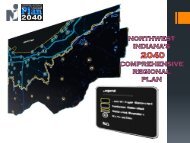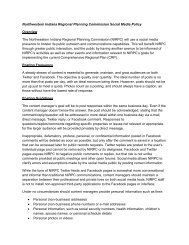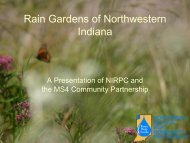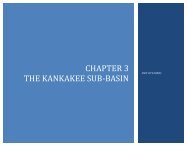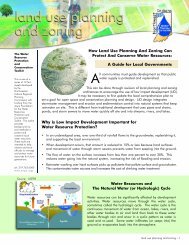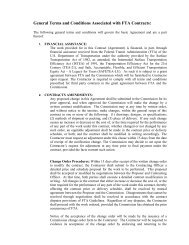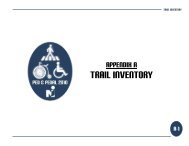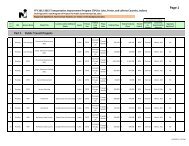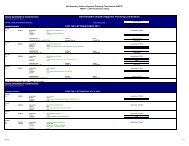Comprehensive Regional Plan - Northwestern Indiana Regional ...
Comprehensive Regional Plan - Northwestern Indiana Regional ...
Comprehensive Regional Plan - Northwestern Indiana Regional ...
You also want an ePaper? Increase the reach of your titles
YUMPU automatically turns print PDFs into web optimized ePapers that Google loves.
2040 CRP Summary / Environment and Green Infrastructure<br />
AIR QUALITY<br />
IMPROVE OUR AIR<br />
Clean air is vital to the productivity of people, land and<br />
businesses in Northwest <strong>Indiana</strong>. Poor air quality can<br />
cause a myriad of health problems such as heart disease<br />
and asthma. Our region has struggled with maintaining<br />
healthy air standards because of our industrial legacy<br />
and abundance of vehicular traffic. Over the years, our air<br />
quality has improved dramatically because of significant<br />
investments by local industries and vehicle manufacturers<br />
to reduce pollution to comply with federal and state<br />
regulations.<br />
56<br />
Continued progress is necessary, however, over a<br />
broad spectrum of source contributors. Specifically as<br />
the bigger manufacturers reduce their emissions, the<br />
importance of the impacts caused by individuals becomes<br />
greater.<br />
National Ambient Air Quality Standards<br />
The federal government established the National Ambient<br />
Air Quality Standards (NAAQS) as the primary tool to<br />
measure the amount of six critical air pollutants that are<br />
detrimental to human health. Northwest <strong>Indiana</strong> has<br />
achieved “attainment,” or success in each of these six<br />
areas, with the latest involving fine particulate matter<br />
(2009) and ozone (2010). While this is a cause for<br />
celebration for our region, it is important that we maintain<br />
and continue to strive for improvement in air quality.<br />
Air Toxics<br />
Toxics are monitored and regulated differently than NAAQS<br />
pollutants. These are divided into two major groups –<br />
carcinogenic and noncarcinogenic. Both of these are<br />
measured at five air toxic monitoring sites throughout the<br />
region operated by the <strong>Indiana</strong> Department of Environmental<br />
Management (IDEM). Predictably, these toxics are most<br />
prevalent in urbanized areas.



